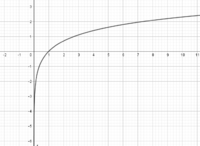I have trying to sketch the graph of y= ln(x^2-6x+10). I managed to do this by looking at y=x^2-6x+10 first:

Then thinking about y=ln(x) separately:

And then building up the ideas to draw y= ln(x^2-6x+10) which turns out to be this:

( I also did some calculus to confirm turning points etc.)
However, my question is this:
Neither the quadratic nor the log function have points of inflection but the final graph does. This is a surprise to me. I can explain this algebraically but graphically i can't see why this would be true?
Can anyone help me see why points of inflection appear through a graphical argument?

Then thinking about y=ln(x) separately:

And then building up the ideas to draw y= ln(x^2-6x+10) which turns out to be this:

( I also did some calculus to confirm turning points etc.)
However, my question is this:
Neither the quadratic nor the log function have points of inflection but the final graph does. This is a surprise to me. I can explain this algebraically but graphically i can't see why this would be true?
Can anyone help me see why points of inflection appear through a graphical argument?
